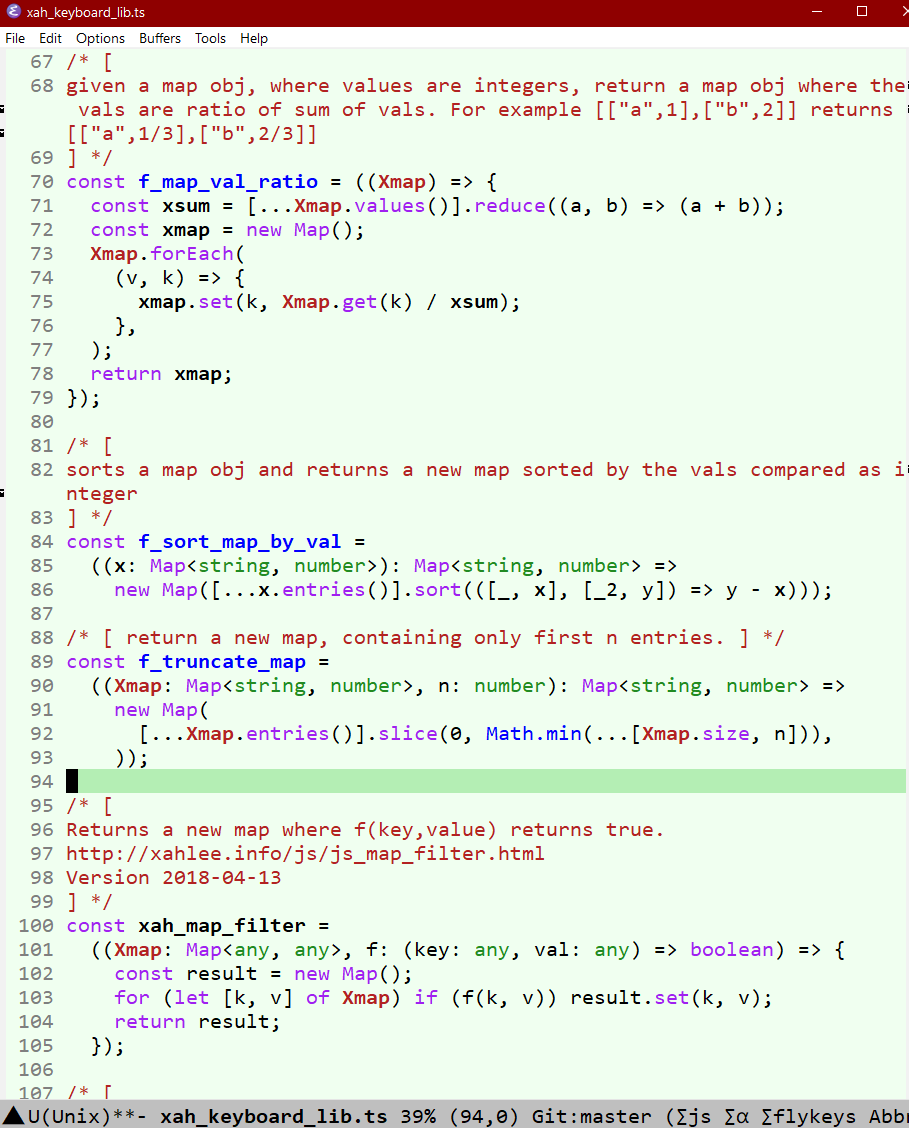Xah JavaScript Style Guide for Functional Programers
Xah's JavaScript style guide, for functional programing. Ordered roughly from most important to less.

Code Formatting
use deno fmt filename
Never use var
Never use var.
It is from early days of JavaScript.
It has complex variable scope
, and complex name-hoisting behavior.
Always use let or const instead.
Always Declare Variable
Never have undeclared variable such as:
x = 3
Undeclared variables becomes properties of global property.
Declare variable by let or const
Never Use Double Equal
- Never use double equal
==. - It does type conversion implicitly, which returns
truefor[] == "", etc. - Use triple equal
===instead.
Never Use for-in Loop
When you use for-in Loop, it goes thru the Prototype Chain. That's almost never what you want.
To go thru properties, use:
Object.keys
then use
Array.prototype.forEach
Never Use “with” Statement
The with statement creates semantic ambiguity of code inside its curly brackets,
if local variable are declared using var, it can mean the property of a object.
const jj = {x:4}; with (jj) { var x = 3; // x is meant to be local variable } console.log( jj ); // { x: 3 } // jj.x is changed
const jj = {x:4}; with (jj) { let x = 3; } console.log( jj ); // { x: 4 } // jj.x is not changed
Never assign array by index
this creates JS: Sparse Array
- use
pop,push,shift,unshift,splice - JS: Array.prototype
// define a empty array const xx = []; // assign a value to a slot xx[0] = 82; xx[1] = 34; xx[3] = 96; console.log(xx); // [ 82, 34, <1 empty item>, 96 ] // value of xx[2] do not exist
Never Use the Delete Operator
Never use the delete operator
- The return value is true even if argument is not object.
- On array, it creates Sparse Array.
- On object, it is inefficient.
Use:
Better is actually never delete property of a non-array object. Set the property value to null, if you must.
If you are using data object as a dictionary, use
Map
Never Use the Arguments Object
Don't use the arguments object.
You never need it.
It makes code hard to understand, and JavaScript compilers have difficulty optimizing it.
Use:
Never Use the Property named “constructor”
Never use the property key "constructor". Because its value can be anything.
f.prototype.constructorcan be changed anytime by user.f.prototypecan also be changed anytime by user.
Never use the instanceof Operator
Never use the instanceof Operator.
Because, what it actually does may not be what you expect, and there are better ways to do what you want.
obj instanceof f is basically the same as f.prototype.isPrototypeOf(obj).
Lots of things can go wrong, because:
- The value
f.prototypecan be changed anytime. - Parent of object can also change anytime.
To find a object's subtype, use
Reflect.apply( Object.prototype.toString , val, [] )
〔see Determine Type of Object〕
To determine if a object is in the Prototype Chain of another, use Object.prototype.isPrototypeOf .
Never Use Object Constructor “Object()”
Never use the
Object Constructor
Object(…) to create a object,
because its behavior is complex. Use it only to convert a Primitive Value to object type.
To create object,
use
Object Literal Expression
{…}, or use
Object.create
.
Never Use Keyword “this”
Never use the keyword this.
Because, its value is dependent on calling context in a complex way.
〔see JS: this (binding)〕
Use Object.create
Douglas Crockford, said he stopped using this and new.
〔see Douglas Crockford the Better Parts: the Bads Parts Reconsidered〕
Never Use new (Operator)
Avoid using new (operator), because its behavior is extremely complex, and drags in all the extremely other complex parts
Instead, write a function that returns a object, and or use
Object.create
.
This way, you can more simply and reliably specify parent object.
Never Use Getter/Setter Properties
Getter Setter Properties are complex, and are not necessary. They are methods pretending to be properties. Just define methods explicitly if you need to. This way, it is explict what the code is doing.
Always Use Semicolon
Always use semicolon. Omitting semicolon creates hard-to-find bugs.
Never use Function.prototype.Call, Function.prototype.Apply
See Function Call, Apply, Bind.
Use Reflect.apply instead, because it avoids JavaScript's complex Prototype Chain, and makes the code clearer.
Never Use Keyword “function” to Define a Function
Functions defined by keyword function has the following complexities.
- JS: this (binding)
- JS: Function Name Hoisting
- JS: arguments (object)
- Nested function scope complexity.
Always use Arrow Function.
Arrow function do not have thisBinding nor argument object, nor hoisting behavior nor nesting scope problems.
And arrow function can be moved anywhere, including inside if statement or any block construct.
The name will be local to that code block.
Never Use Keyword “class”
The Class is a syntax shortcut for JavaScript's prototype object system, which drag you into all the bad things about it.
Program functionally. Just use Arrow Function
Avoid Using “eval()”
Using eval is sort of meta programing. But it has several problems.
- It is a security risk. For example, user's arbitrary input could be evaluated.
- It is bug prone. It is hard to debug and tell what it is doing, because the code is not known until run-time.
- It is slow. Because JavaScript has to parse it and run it at run time.